
How to Make Saskatoon Syrup - Easily! With Step-by-step Photos, Recipe, Directions, Ingredients and Costs
How to Make Homemade Saskatoon Syrup - Easily!
(NOTE: This recipe works equally well with other types of berries, such as strawberries, blackberries, raspberries, etc.)
Click here for a PDF print version!
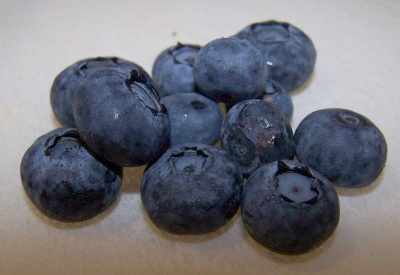 Making
and canning your own saskatoon syrup is so easy. Juices from fresh or
frozen saskatoons are easily made into toppings for use on ice cream and
pastries. Here's how to do it, in 12 simple steps and completely
illustrated.
For more information about saskatoons, see
Saskatoon Recipes,
Information and Picking Tips.
Making
and canning your own saskatoon syrup is so easy. Juices from fresh or
frozen saskatoons are easily made into toppings for use on ice cream and
pastries. Here's how to do it, in 12 simple steps and completely
illustrated.
For more information about saskatoons, see
Saskatoon Recipes,
Information and Picking Tips. Ingredients
- Saskatoons - 6 to 7 cups of fresh or frozen saskatoons OR other berries of your choice (examples: strawberries, raspberries, blackberries).
- Lemon juice - either fresh squeezed or bottled. 2 tablespoons.
- Sugar - Sugar to taste, traditional (Ball) recipes use 7 cups of dry, granulated (table) sugar. It is
possible to make low-sugar, fruit juice-sweetened, or Stevia (in a prepared form like Truvia, it measures same as sugar; if you use another form, you will need do your own conversion) - or Splenda, if you prefer, -sweetened syrup; I'll point out
the differences below.
See the notes on sugar below for more information.
Equipment
- At least 1 large pot; I prefer 16 to 20 quart Nonstick ceramic coated pots for easy cleanup.
- Large spoons and ladles,
- 1 Water Bath Canner (a huge pot to sanitize the jars after filling (about $30 to $35 at mall kitchen stores, sometimes at big box stores and grocery stores.). Note: we sell canners and supplies here, too - at excellent prices - and it helps support this web site!
- Half pint canning jars (Grocery stores, like Publix, Kroger, Safeway carry them, as do some big box stores - about $7 per dozen 8 ounce jars including the lids and rings)
- Lids - thin, flat, round metal lids with a gum binder that seals them against the top of the jar. They may only be used once.
- Rings - metal bands that secure the lids to the jars. They may be reused many times.
- Jar funnel ($5 at Target, other big box stores, and often grocery stores; and available online - see this page) or order it as part of the kit with the Jar grabber .
- Jar grabber (to pick up the hot jars)- Big box stores and grocery stores sometimes carry them; and it is available online - see this page. It's a tremendously useful to put jars in the canner and take the hot jars out (without scalding yourself!). The kit sold below has everything you need, and at a pretty good price
Optional stuff:
- Foley Food Mill - not necessary; useful if you want to remove seeds (from blackberries) or make applesauce.
- Lid lifter (has a magnet to pick the lids out of the almost-boiling water where you sanitize them. ($4 at big box stores or it comes in the kit at left)
Saskatoon Syrup-making Directions
This example shows you how to make saskatoon (or any berry) syrup! The yield from this recipe is about 9 or 10 eight-ounce jars (which is the same as 5 pints).
Step 1 - Pick the saskatoons! (or buy them already picked)
It's fun to go pick your own and you can obviously get better quality ones!
I prefer to grow my own; which is really easy - but that does take
some space and time.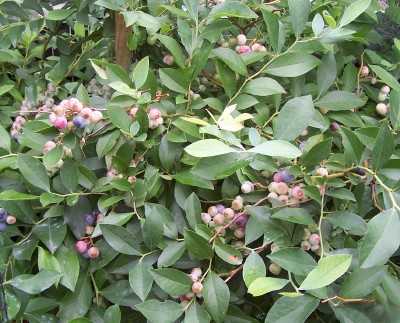
As mentioned in the Ingredients section; you may use frozen saskatoons (those without syrup or added sugar); which is especially useful if you want to make some syrup in December to give away at Christmas!
At left are saskatoons (in my yard, actually; they make a great hedge or landscaping bush) almost ripe! If you want to pick your own, here is a list and links to the pick your own farms.
Step 2 - How much fruit?
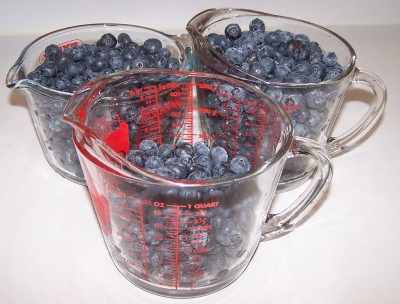 Syrup
can be made in any size batch, but the 6 cups of fresh or frozen
berries at a time is normal and manageable - it is difficult to get even
heating on larger batches) You can scale the recipe down, if
desired, to make any smaller amount.
Syrup
can be made in any size batch, but the 6 cups of fresh or frozen
berries at a time is normal and manageable - it is difficult to get even
heating on larger batches) You can scale the recipe down, if
desired, to make any smaller amount.
Step 3 - Wash the jars and lids
Now's a good time to get the jars ready, so you won't be rushed later. The dishwasher is fine for the jars; especially if it has a "sanitize" cycle, the water bath processing will sanitize them as well as the contents! If you don't have a dishwasher with a sanitize cycle, you can wash the containers in hot, soapy water and rinse, then sanitize the jars by boiling them 10 minutes, and keep the jars in hot water until they are used.
 NOTE: If a canning recipe calls for 10 minutes or more of process time in the canner, then the jars do not need to be "sanitized" before filling them.
But really, sanitizing them first is just good hygeine and common sense! See this page for more detail about cleaning and sanitizing jars and lids.
NOTE: If a canning recipe calls for 10 minutes or more of process time in the canner, then the jars do not need to be "sanitized" before filling them.
But really, sanitizing them first is just good hygeine and common sense! See this page for more detail about cleaning and sanitizing jars and lids.
Put the lids into a pan of hot, but not quite boiling water (that's what the manufacturer's recommend) for 10 minutes, and use the magnetic "lid lifter wand" to pull them out.
Leave the jars in the dishwasher on "heated dry" until you are ready to use them. Keeping them hot will prevent the jars from breaking when you fill them with the hot syrup.
Need lids, rings and replacement jars?
Get them all here, delivered:
Lids: put the very hot (but not quite boiling; around 180 F, steaming water is fine)
water for at least several
minutes; to soften up the gummed surface and clean the lids. I just
leave them in there, with the heat on very low, until I need them!
Step 4 -Wash the berries and sort!
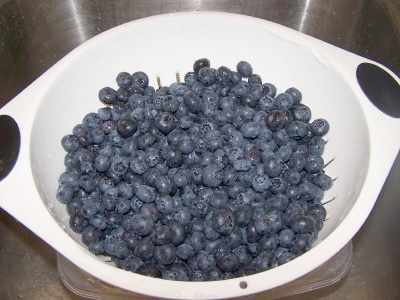 I'm
sure you can figure out how to wash the fruit in a colander of plain cold
water.
I'm
sure you can figure out how to wash the fruit in a colander of plain cold
water.
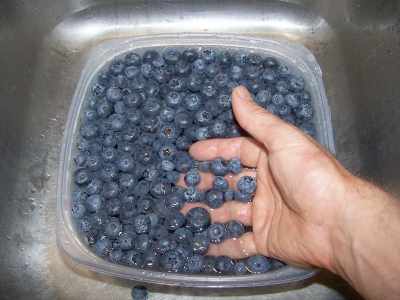 Then
you need to pick out and remove any bits of stems, leaves and soft or
mushy berries. It is easiest to do this in a large bowl of water and
gently run your hands through the berries as they float. With your
fingers slightly apart, you will easily feel any soft or mushy berries get
caught in your fingers.
Then
you need to pick out and remove any bits of stems, leaves and soft or
mushy berries. It is easiest to do this in a large bowl of water and
gently run your hands through the berries as they float. With your
fingers slightly apart, you will easily feel any soft or mushy berries get
caught in your fingers.
Then just drain off the water!
Step 5 - Crush the berries
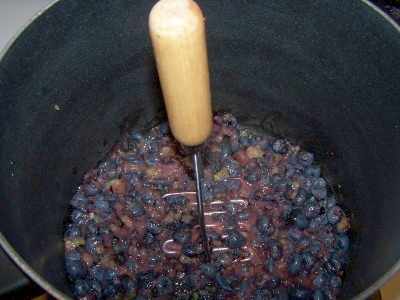 You
can go wild, be a conquering Genghis Khan crushing the peasants.. watch them
flee. Well, if they're not fleeing, the berries sure do manage to roll
everywhere. You won't find them until the next time you clean behind
your refrigerator!
You
can go wild, be a conquering Genghis Khan crushing the peasants.. watch them
flee. Well, if they're not fleeing, the berries sure do manage to roll
everywhere. You won't find them until the next time you clean behind
your refrigerator!
Anyway, to crush them, you can either do one layer at
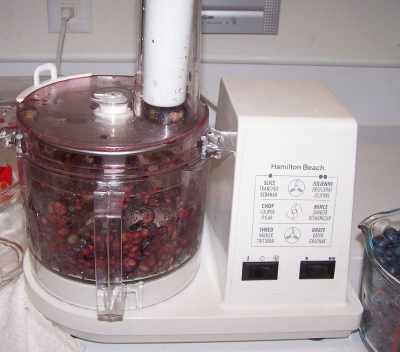 a
time in a pan or bowl, using a potato masher..
a
time in a pan or bowl, using a potato masher..
OR you can be lazy like me and use the slice mode on your food processor. If
you have a juicer, you can use that instead!
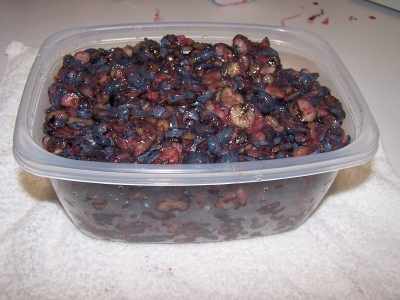
Step 6 - Measure out the sweetener
You can make syrup with sugar, fruit juice or artificial sweetener, depending upon your needs.
| Type of syrup | Sweetener |
| regular | 7 cups of sugar |
| low sugar | 4.5 cups of sugar |
| lower sugar | 2 cups sugar and 2 cups Splenda (or about 1/3 that if you use Stevia, which is my preference) |
| no sugar | 4 cups Splenda (or about 1/3 that if you use Stevia, which is my preference) |
| natural | 3 cups frozen concentrated fruit juice (grape, peach, apple or mixed) |
Step 7 - Mix the saskatoons with the lemon juice and cook to a full boil
Add the 2 tablespoons of lemon juice and heat the saskatoons in a big pot to boiling and simmer until soft (5 to 10 minutes).
Step 8 - Strain the cooked berries
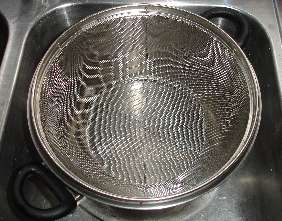 Strain
the hot berries through a colander (I use a sieve that fits just inside a
large pot, or for more pulp bits, use a Foley Food Mill) and let them
drain until they are cool enough to handle.
Strain
the hot berries through a colander (I use a sieve that fits just inside a
large pot, or for more pulp bits, use a Foley Food Mill) and let them
drain until they are cool enough to handle.
Step 9 - Strain again through cheesecloth
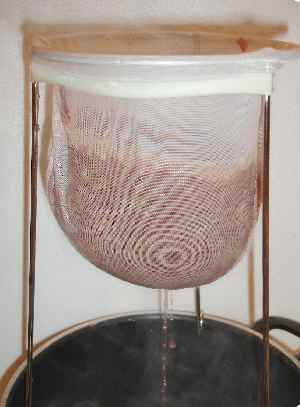 If
you want a more clarified (clear) syrup, strain the collected juice through
a double layer of cheesecloth OR a jelly bag. Discard the dry pulp. The
yield of the pressed juice should be about 4 to 5 cups. You tend to get a
better yield when you use a juicer; they are more efficient.
If
you want a more clarified (clear) syrup, strain the collected juice through
a double layer of cheesecloth OR a jelly bag. Discard the dry pulp. The
yield of the pressed juice should be about 4 to 5 cups. You tend to get a
better yield when you use a juicer; they are more efficient.
Step 10 - Add the sweetener
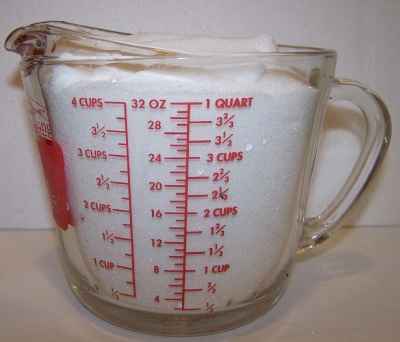 Combine
the juice with 7 cups of sugar (or your other choice and quantity of
sweetener) in a large saucepan, bring it to boiling, and simmer for 1
minute. Remove from heat and skim off any foam.
Combine
the juice with 7 cups of sugar (or your other choice and quantity of
sweetener) in a large saucepan, bring it to boiling, and simmer for 1
minute. Remove from heat and skim off any foam.
NOTE: To make a syrup with whole fruit pieces, save 1 or 2 cups of the fresh or frozen fruit, combine these with the sugar, and simmer as in making syrup without fruit pieces.
Step 11 - Fill the jars and put the lid and rings on
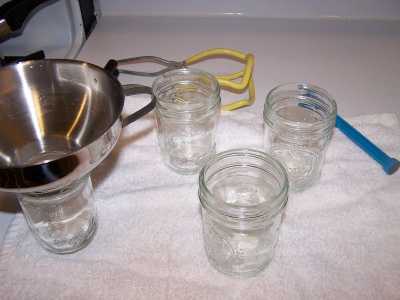 Fill
them to within to inch of the top, wipe any spilled syrup off the top,
seat the lid and tighten the ring around them. Then put the filled jars into the canner!
Fill
them to within to inch of the top, wipe any spilled syrup off the top,
seat the lid and tighten the ring around them. Then put the filled jars into the canner!
This is where the jar tongs and lid lifter come in really handy!
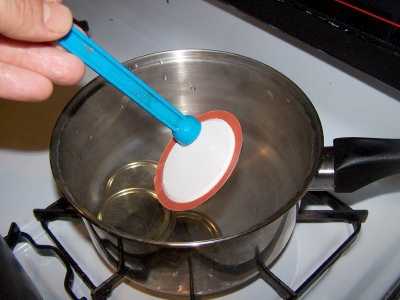
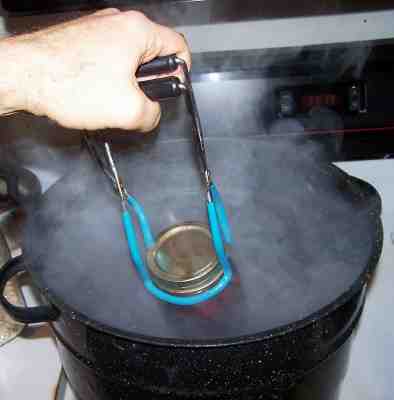
Step 12 - Process the jars in the boiling water bath
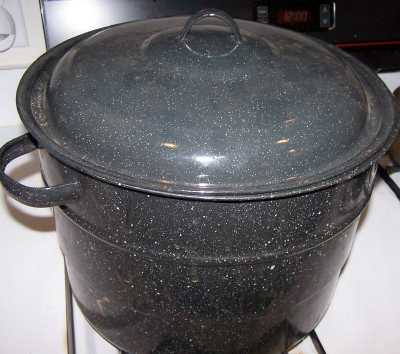 Keep
the jars covered with at least 2 inches of water. Keep the water
boiling. In general, boil them for 10 to 15 minutes. I say "in
general" because it depends upon the jar size and altitude. You have to
process (boil) them longer at higher altitudes than sea level, or if you
use larger jars, or if you did not sanitize the jars and lids right
before using them. See the table below:
Keep
the jars covered with at least 2 inches of water. Keep the water
boiling. In general, boil them for 10 to 15 minutes. I say "in
general" because it depends upon the jar size and altitude. You have to
process (boil) them longer at higher altitudes than sea level, or if you
use larger jars, or if you did not sanitize the jars and lids right
before using them. See the table below:
| Recommended Process Times in a Boiling-Water Canner for Hot Pack Berry Syrups | |||
|
Process times (in minutes) for altitudes of |
|||
| Jar size | 0-1,000 ft. | 1,001 -6,000 ft. | Over 6,000 ft |
| Half-pints | 10 min | 15 min | 20 min |
| Pints | 10 min | 15 min | 20 min |
Step 13 - Remove and cool the jars - Done!
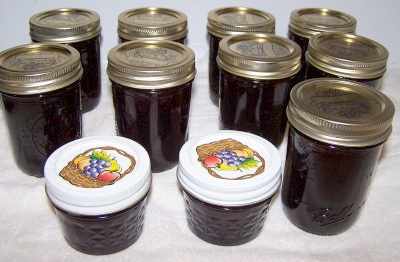 Lift
the jars out of the water and let them cool without touching or bumping
them in a draft-free place (usually takes overnight) You can then remove
the rings if you like, but if you leave them on, at least loosen them
quite a bit, so they don't rust in place due to trapped moisture. Once
the jars are cool, you can check that they are sealed verifying that the
lid has been sucked down. Just press in the center, gently, with your
finger. If it pops up and down (often making a popping sound), it is not
sealed. If you put the jar in the refrigerator right away, you can still
use it. Some people replace the lid and reprocess the jar, then that's a
bit iffy. If you heat the contents back up, re-jar them (with a new lid)
and the full time in the canner, it's usually ok.
Lift
the jars out of the water and let them cool without touching or bumping
them in a draft-free place (usually takes overnight) You can then remove
the rings if you like, but if you leave them on, at least loosen them
quite a bit, so they don't rust in place due to trapped moisture. Once
the jars are cool, you can check that they are sealed verifying that the
lid has been sucked down. Just press in the center, gently, with your
finger. If it pops up and down (often making a popping sound), it is not
sealed. If you put the jar in the refrigerator right away, you can still
use it. Some people replace the lid and reprocess the jar, then that's a
bit iffy. If you heat the contents back up, re-jar them (with a new lid)
and the full time in the canner, it's usually ok.
Once cooled, they're ready to store. I find they last up to 12 months. But after about 6 to 8 months, they get darker in color and start to get runny. They still are safe to eat, but the flavor and texture aren't as good. So eat them in the first 6 months after you prepare them!
Notes on sugar in berry syrups
What size batch can you make?
Syrups are different from jam and jelly recipes, there's really no minimum or maximum because you're not using pectin and trying to get a precise degree of gel or set. It's just juice (liquid ) that is reduced by cooking it down and adding sugar.
If it's very dry or thick, you can add water or even blueberry juice or apple juice or some other acidic juice that you have available to achieve the thickness of syrup that you like!
How much sugar or sweetener is needed
The USDA's National Center for Home Food Preservation and the Ball Blue Book both call for about the same amount of sugar, primarily I believe, because they're using it as a thickener. Sugar in very high concentration does add some preservative properties, but mostly it improves the color and flavor.
Since both authorities agree the berry juices can be canned safely without the addition of any sugar whatsoever, it's pretty obvious you can reduce the sugar to suit your own taste in this recipe without any risk. There's no difference between berry juice and berry syrup except for the addition of the sugar. Berry syrup is even cooked considerably longer which if anything would improve the safety.
Our recipe even adds a couple of tablespoons of lemon juice to ensure that the acidity is maintained. Acidity, proper heat processing and the use of proper canning jars, processed in a canner are what ensures the shelf stability and safety of canned berry juices.
Other Equipment:From left to right:
|
 You can get all of the tools in a kit here: See here for related tools, equipment, supplies on Amazon |
 Granite Ware 21 QT, 9 Piece Enamelware Water bath Canning Pot with Canning kit, Colander and Rack VKP Brands Water Bath AND Steam Canner, 20 Quart Stainless Steel, flat-bottomed Induction range compatible and safe for smooth top ranges. 
|
Home Canning KitsSee the seller's website for more information, features, pricing and user reviews! This is the same type of standard canner that my grandmother used to make everything from applesauce to syrups and jellies to tomato and spaghetti sauce. This complete kit includes everything you need and lasts for years: the canner, jar rack, Jar grabber tongs, lid lifting wand, a plastic funnel, labels, bubble freer, and the bible of canning, the Ball Blue Book. It's much cheaper than buying the items separately. You will never need anything else except jars and lids (and the jars are reusable). To see more canners, of different styles, makes and prices, click here!
|
Canning booksCanning & Preserving for Dummies Get Canning and Preserving For Dummies |
|
The All New Ball Book Of Canning And Preserving: Over 350 of the Best Canned, Jammed, Pickled, and Preserved Recipes PaperbackThis is THE book on canning! My grandmother used this book when I was a child. It tells you in simple instructions how to can almost anything; complete with recipes for syrup, jellies, pickles, sauces, canning vegetables, meats, etc. If it can be canned, this book likely tells you how! Click on the link below for more information and / or to buy (no obligation to buy)
Click here for more information about the Ball Blue Book of Preserving
|
Summary - Cost of Making Homemade Saskatoon Syrup - makes 10 jars, 8 oz each** |
||||
| Item | Quantity | Cost in 2025 | Source | Subtotal |
| Saskatoons | 1 gallon | $10.00/gallon | Pick your own | $10.00 |
| Canning jars (8 oz size), includes lids and rings | 10 jars | $11/dozen 8 oz jars or $0.92/jar |
Grocery stores, like Public, Kroger, Safeway and sometimes, Big Lots, local hardware stores and big box stores | $5.60 |
| Sugar | 5 cups | $2.50 | Grocery stores, like Public, Kroger, Safeway and sometimes, Big Lots, local hardware stores and big box stores | $2.50 |
| Total | $18.10 total or about $1.81 per 8 oz jar |
|||
|
* - This assumes you already have the pots, pans, ladles,, and reusable equipment. Note that you can reuse the jars, and that reduces the cost! Just buy new lids (the rings are reusable, but the flat lids are not)! |
||||






